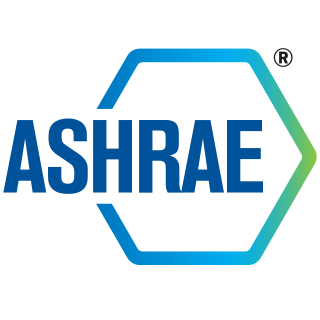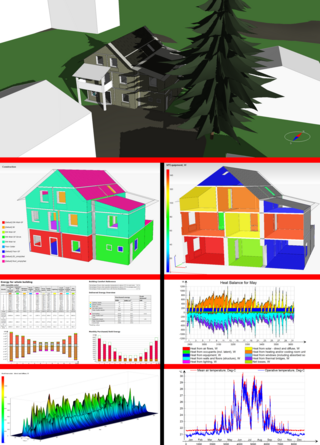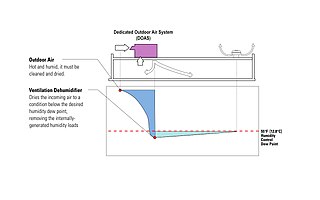Related Research Articles

Heating, ventilation, and air conditioning (HVAC) is the use of various technologies to control the temperature, humidity, and purity of the air in an enclosed space. Its goal is to provide thermal comfort and acceptable indoor air quality. HVAC system design is a subdiscipline of mechanical engineering, based on the principles of thermodynamics, fluid mechanics, and heat transfer. "Refrigeration" is sometimes added to the field's abbreviation as HVAC&R or HVACR, or "ventilation" is dropped, as in HACR.

Energy conservation is the effort to reduce wasteful energy consumption by using fewer energy services. This can be done by using energy more effectively or changing one's behavior to use less service. Energy conservation can be achieved through efficient energy use, which has some advantages, including a reduction in greenhouse gas emissions and a smaller carbon footprint, as well as cost, water, and energy savings.

Ventilation is the intentional introduction of outdoor air into a space. Ventilation is mainly used to control indoor air quality by diluting and displacing indoor pollutants; it can also be used to control indoor temperature, humidity, and air motion to benefit thermal comfort, satisfaction with other aspects of the indoor environment, or other objectives.
BACnet is a communication protocol for building automation and control (BAC) networks that use the ASHRAE, ANSI, and ISO 16484-5 standards protocol.

Underfloor heating and cooling is a form of central heating and cooling that achieves indoor climate control for thermal comfort using hydronic or electrical heating elements embedded in a floor. Heating is achieved by conduction, radiation and convection. Use of underfloor heating dates back to the Neoglacial and Neolithic periods.
Building performance is an attribute of a building that expresses how well that building carries out its functions. It may also relate to the performance of the building construction process. Categories of building performance are quality, resource savings and workload capacity. The performance of a building depends on the response of the building to an external load or shock. Building performance plays an important role in architecture, building services engineering, building regulation, architectural engineering and construction management. Furthermore, improving building performance is important for addressing climate change, since buildings account for 30% of global energy consumption, resulting in 27% of global greenhouse gas emissions. Prominent building performance aspects are energy efficiency, occupant comfort, indoor air quality and daylighting.

Building insulation is material used in a building to reduce the flow of thermal energy. While the majority of insulation in buildings is for thermal purposes, the term also applies to acoustic insulation, fire insulation, and impact insulation. Often an insulation material will be chosen for its ability to perform several of these functions at once.
The California Energy Code, called simply Title 24 in industry, is the sixth section of the California Building Standards Code. The code was created by the California Building Standards Commission in 1978 in response to a legislative mandate to reduce California's energy consumption. These standards are updated periodically by the California Energy Commission. The code includes energy conservation standards applicable to most buildings throughout California.
In construction, commissioning or commissioning process is an integrated, systematic process to ensure, through documented verification, that all building systems perform interactively according to the "Design Intent". The commissioning process establishes and documents the "Owner's Project Requirements (OPR)" criteria for system function, performance expectations, maintainability; verify and document compliance with these criteria throughout all phases of the project. Commissioning procedures require a collaborative team effort and 'should' begin during the pre-design or planning phase of the project, continue through the design and construction phases, initial occupancy phase, training of operations and maintenance (O&M) staff, and into occupancy.
The International Green Construction Code (IGCC) is a set of guidelines that aim to improve the sustainability and environmental performance of buildings during their design, construction, and operation. It was introduced by the International Code Council (ICC), a non-profit organization that provides building safety and fire prevention codes for the United States and other countries. It is a model code designed to be mandatory where it is implemented.

A dedicated outdoor air system (DOAS) is a type of heating, ventilation and air-conditioning (HVAC) system that consists of two parallel systems: a dedicated system for delivering outdoor air ventilation that handles both the latent and sensible loads of conditioning the ventilation air, and a parallel system to handle the loads generated by indoor/process sources and those that pass through the building enclosure.

United States building energy codes are a subset of building codes that set minimum requirements for energy-efficient design and construction for new and renovated buildings. The intent of these energy codes is to moderate and reduce energy use and emissions throughout the lifetime of a building. Energy code provisions may include various aspects of building design and construction, such as: HVAC systems, building envelope, electrical, and lighting systems. There are building energy codes for both commercial and residential buildings. However, just as the United States does not have a national building code, it also does not have a national building energy code; rather, state, and local governments choose to adopt—and potentially revise—national model energy codes and standards. Consequently, building energy codes, and building codes in general, vary between states and jurisdictions.
United States Lighting Energy Policy is moving towards increased efficiency in order to lower greenhouse gas emissions and energy use. Lighting efficiency improvements in the United States can be seen through different standards and acts. The Energy Independence and Security Act of 2007 laid out changes in lighting legislation for the United States. This set up performance standards and the phase-out of incandescent light bulbs in order to require the use of more efficient fluorescent lighting. EISA 2007 is an effort to increase lighting efficiency by 25-30%. Opposition to EISA 2007 is demonstrated by the Better Use of Light Bulbs Act and the Light Bulb Freedom of Choice Act. The efforts to increase lighting efficiency are also demonstrated by the Energy Star program and the increase efficiency goals by 2011 and 2013. A ban on the manufacture and sale of most general purpose incandescent bulbs in the U.S. took effect on August 1, 2023.
Plug load is the energy used by products that are powered by means of an ordinary AC plug. This term generally excludes building energy that is attributed to major end uses
GreenRight Certified (GreenRighting) is a certification program rewarding commercial and industrial green buildings that meet a defined set of energy efficiency standards relating to lighting equipment, lighting systems, lighting power density (LPD), and associated building code compliance.
Lighting Power Density (LPD) is a lighting power requirement defined in North America by the American National Standards Institute (ANSI), American Society of Heating, Refrigerating and Air-Conditioning Engineers (ASHRAE), and the Illuminating Engineering Society of North America (IESNA) Lighting subcommittee.

The American Society of Heating, Refrigerating and Air-Conditioning Engineers is an American professional association seeking to advance heating, ventilation, air conditioning and refrigeration (HVAC&R) systems design and construction. ASHRAE has over 50,000 members in more than 130 countries worldwide.

Building performance simulation (BPS) is the replication of aspects of building performance using a computer-based, mathematical model created on the basis of fundamental physical principles and sound engineering practice. The objective of building performance simulation is the quantification of aspects of building performance which are relevant to the design, construction, operation and control of buildings. Building performance simulation has various sub-domains; most prominent are thermal simulation, lighting simulation, acoustical simulation and air flow simulation. Most building performance simulation is based on the use of bespoke simulation software. Building performance simulation itself is a field within the wider realm of scientific computing.
ANSI/ASHRAE Standard 55: Thermal Environmental Conditions for Human Occupancy is an American National Standard published by ASHRAE that establishes the ranges of indoor environmental conditions to achieve acceptable thermal comfort for occupants of buildings. It was first published in 1966, and since 2004 has been updated every three to six years. The most recent version of the standard was published in 2023.

Moisture Removal Efficiency (MRE) is a measure of the energy efficiency of any dehumidification process. Moisture removal efficiency is the water vapor removed from air at a defined inlet air temperature and humidity, divided by the total energy consumed by the dehumidification equipment during the same time period, including all fan and pump energy needed to move air and fluids through the system.
References
- 1 2 3 4 5 6 American Society of Heating, Refrigerating and Air-Conditioning Engineers, Inc. (2007). Ashrae standard 90.1. Atlanta, GA
- 1 2 U.S. Department of Energy, Initials. (2004). Ansi/ashrae/iesna standard 90.1-2004u. Retrieved from "Archived copy" (PDF). Archived from the original (PDF) on 2011-10-05. Retrieved 2011-03-25.
{{cite web}}: CS1 maint: archived copy as title (link) - ↑ NAIMA, Initials. (2004, Jan/Feb). State adoption of ashrae 90.1. Retrieved from "Archived copy" (PDF). Archived from the original (PDF) on 2011-07-21. Retrieved 2011-03-25.
{{cite web}}: CS1 maint: archived copy as title (link) - ↑ Code Status: Commercial http://energycodesocean.org/code-status-commercial Accessed 15 November 2020
- 1 2 Kirkwood RR, "The Genesis of Standard 90: ASHRAE Takes On Energy Standard" ASHRAE Journal, June 2010. https://www.ashrae.org/File%20Library/docLib/Public/20100625_ASHRAEDAJ10Jun0320100527.pdf Archived 2013-08-13 at the Wayback Machine Accessed 12 June 2014
- ↑ American Society of Heating, Refrigerating and Air-Conditioning Engineers, Inc., . (2010). Ashrae standard 90.1. Atlanta, GA
- ↑ "Archived copy" (PDF). Archived from the original (PDF) on 2014-04-16. Retrieved 2014-04-15.
{{cite web}}: CS1 maint: archived copy as title (link) - ↑ "Statutory Requirements". EnergyCodes.gov. Retrieved 23 November 2020.
- ↑ ANSI/ASHRAE/IES Standard 90.1-2013 Determination of Energy Savings: Quantitative Analysis (PDF) (Report). Pacific Northwest National Laboratory for U.S Department of Energy. August 2014. Retrieved 23 November 2020.
- 1 2 "Standard 90.1 Document History". ashrae.org. Retrieved 23 November 2020.
- ↑ "STANDARD 90.1 APPENDIX G 2013: PERFORMANCE RATING METHOD". ashrae.org. Retrieved 23 November 2020.
- ↑ "Determinations; Building Energy Codes Program". energycodes.org. Retrieved 23 November 2020.
- ↑ Energy Savings Analysis: ANSI/ASHRAE/IES Standard 90.1-2016 (PDF) (Report). October 2017. Retrieved 23 November 2020.
- ↑ "Performance Based Compliance". energycodes.gov. Retrieved 23 November 2020.
- ↑
Rosenberg, Michael I., and Hart, Philip R. Developing Performance Cost Index Targets for ASHRAE Standard 90.1 Appendix G – Performance Rating Method. United States: N. p., 2016. Web. doi:10.2172/1240225. - ↑ "STANDARD 90.1-2019 -- ENERGY STANDARD FOR BUILDINGS EXCEPT LOW-RISE RESIDENTIAL BUILDINGS" . Retrieved 23 November 2020.
- 1 2 "ASHRAE Bookstore" . Retrieved 23 November 2020.